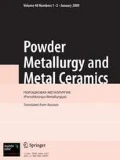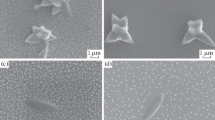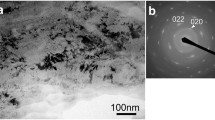Thin metal films deposited on a nonmetallic material can become fragmented in heating. The higher the adhesion in the contact pair, the lower the tendency to fragmentation. Zirconia can lose oxygen to form nonstoichiometric phases; this can influence zirconia-to-metal adhesion. The effect of zirconia stoichiometry on zirconia interaction with thin metal films was studied. Platinum, palladium, nickel, and copper films 100 nm thick were deposited onto substrates of stoichiometric (ZrO2) and nonstoichiometric (ZrO2–x) zirconia using the electron-beam method. The single-crystalline substrates with metal films were annealed in vacuum at temperatures 30–10% lower than the melting points of the deposited metals on the absolute scale and then studied with an optical microscope. The metal films became fragmented on the ZrO2 substrates and interacted with the ZrO2–x substrates to form new uniform phases. The nickel film interacted with the ZrO2–x substrate at lower temperatures than those at which it became fragmented on the ZrO2 substrate. After annealing at 700°C, the copper film on the ZrO2–x substrate led to texture showing areas with the fragmented and uniform coating probably because the excess zirconium in ZrO2–x interacted with the copper film resulting in local restoration of the zirconia stoichiometry near the surface. Therefore, the copper film in the adjacent areas was in contact with stoichiometric zirconia and became fragmented. Thus, as expected, the stoichiometry of zirconia influences the morphology of thin metal films deposited on its surface after annealing: the coating metals interact with nonstoichiometric zirconia, promoting adhesion in the contact pair and preventing the film fragmentation observed on stoichiometric zirconia.





Similar content being viewed by others
References
Yu.V. Naidich, I.I. Gab, B.D. Kostyuk, T.V. Stetsyuk, D.I. Kurkova, and S.V. Dukarov, “Metal nanofilms in brazing (juncture) of ceramics materials,” Dop. Nats. Akad. Nauk Ukrainy, No. 5, 97–104 (2007).
Yu.V. Naidich, Contact Phenomena in Metallic Melts [in Russian], Kyiv (1972), p. 96.
E. Shaffir, I. Riess, and W. D. Kaplan, “The mechanism of initial de-wetting and detachment of thin Au films on YSZ,” Acta Mater., 57, No. 1, 248–256 (2009).
G. Beck and J. Janek, “Twins within platinum and palladium films on YSZ—location for hole formation during de-wetting and oxygen exchange,” Solid State Ionics, 227, 57–65 (2012).
O.V. Durov, M.V. Karpets, T.V. Sidorenko, B.D. Kostyuk, and Yu.V. Naidich, “The role of stoichiometry in contact interaction of zirconia with metal melts,” Powder Metall. Met. Ceram., 55, No. 9–10, 612–616 (2017).
Author information
Authors and Affiliations
Corresponding author
Additional information
Translated from Poroshkova Metallurgiya, Vol. 60, Nos. 3–4 (538), pp. 88–94, 2021.
Rights and permissions
About this article
Cite this article
Durov, O.V., Kostyuk, B., Sydorenko, T.V. et al. The Influence of Zirconia Stoichiometry on the Morphology of Thin Metal Films Deposited on its Surface After Annealing in Vacuum. Powder Metall Met Ceram 60, 198–203 (2021). https://doi.org/10.1007/s11106-021-00228-y
Received:
Published:
Issue Date:
DOI: https://doi.org/10.1007/s11106-021-00228-y




